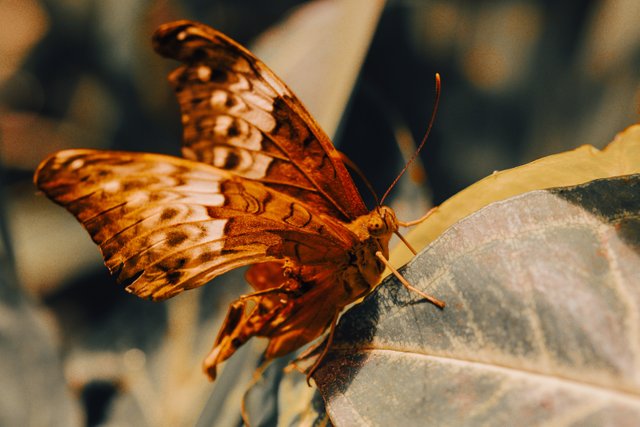Butterflyy pt. 5
Nearly all butterflies are diurnal, have relatively bright colours, and hold their wings vertically above their bodies when at rest, unlike the majority of moths which fly by night, are often cryptically coloured (well camouflaged), and either hold their wings flat (touching the surface on which the moth is standing) or fold them closely over their bodies. Some day-flying moths, such as the hummingbird hawk-moth, are exceptions to these rules.
Butterfly larvae, caterpillars, have a hard (sclerotised) head with strong mandibles used for cutting their food, most often leaves. They have cylindrical bodies, with ten segments to the abdomen, generally with short prolegs on segments 3–6 and 10; the three pairs of true legs on the thorax have five segments each. Many are well camouflaged; others are aposematic with bright colours and bristly projections containing toxic chemicals obtained from their food plants. The pupa or chrysalis, unlike that of moths, is not wrapped in a cocoon.
Sexual dimorphism in Anthocharis cardamines
A mostly white butterfly with orange-tipped wings
Male
A mostly white butterfly with smaller black tips on its wings
Female
Many butterflies are sexually dimorphic. Most butterflies have the ZW sex-determination system where females are the heterogametic sex (ZW) and males homogametic (ZZ).
Distribution and migration
See also: Lists of butterflies of Australia (Tasmania, Victoria), Britain, India, Menorca, North America, Taiwan, and Trinidad and Tobago
Further information: Lepidoptera migration, Insect migration, and Animal navigation
Butterflies are distributed worldwide except Antarctica, totalling some 18,500 species. Of these, 775 are Nearctic; 7,700 Neotropical; 1,575 Palearctic; 3,650 Afrotropical; and 4,800 are distributed across the combined Oriental and Australian/Oceania regions. The monarch butterfly is native to the Americas, but in the nineteenth century or before, spread across the world, and is now found in Australia, New Zealand, other parts of Oceania, and the Iberian Peninsula. It is not clear how it dispersed; adults may have been blown by the wind or larvae or pupae may have been accidentally transported by humans, but the presence of suitable host plants in their new environment was a necessity for their successful establishment.
